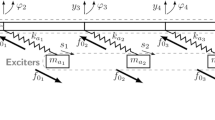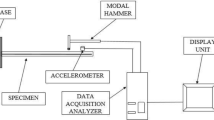Abstract
A topology optimization for the design of rubber vibration isolators is proposed. Many vibration isolators are made of rubbers and they operate under small oscillatory load superimposed on large static deformation. Vibration isolators must have a certain degree of static stiffness in order to endure the static loading due to large gravitational and inertial forces. On the other hand, isolators must have a small dynamic stiffness in order to reduce the force transmission from vibrating systems to base structures. Therefore both the static and dynamic behaviours of rubber should be simultaneously considered in the design process. The static behaviours of rubber under large and slow loads are generally treated with hyperelastic constitutive models. Rubber under fast dynamic loads can be modelled as a viscoelastic material. In this paper, the steady state viscoelastic model, which is suggested by Kim and Youn and correctly predicts the influence of the pre-strain on the relaxation function, is applied for the dynamic analysis. The continuum-based design sensitivity analyses (DSA) of both the static hyperelastic model and dynamic viscoelastic model are developed. The topology optimization formulation is proposed in order to generate the system layouts considering both the static and dynamic performance. The density distribution approach and sequentially linear programming (SLP) are used as the optimization algorithms. Some design examples are presented in order to verify the proposed approach.
Similar content being viewed by others
References
Ashrafiuon, H. 1993: Design optimization of aircraft engine-mount systems. J Vib Acoust 115, 463–467
Chang, S.-Y.; Cho, J.-H.; Youn, S.-K.; Kim, C.-S.; Oh, D.-H. 2001: Topology Optimization of a HDD Actuator Arm. Comput Struct Eng 1, 89–96
Choi, K.K.; Duan, W. 2000: Design sensitivity analysis and shape optimization of structural components with hyperelastic material. Comput Methods Appl Mech Eng 187, 219–243
Christensen, R.M. 1982: Theory of viscoelasticity. New York: Academic press
Jung, G.D.; Youn, S.K.; Kim, B.K. 2000: A three dimensional nonlinear viscoelastic constitutive model of solid propellant. Int J Solids Struct 37, 4715–4732
Ki, S.H.; Wang, S.M. 2001: Topology optimization of hyperelastic material. Proc. 4th World Cong. of structural and multidisciplinary optimization
Kim, B.-K.; Youn, S.-K. 2001: A viscoelastic constitutive model of rubber under small oscillatory loads superimposed on large static deformation. Arch Appl Mech 71, 748–763
Kim, B.-K.; Youn, S.-K.; Lee, W.-S. 2002: FEA of rubber under small steady state vibration superimposed on large static deformation. Proc. 34-th Solid Mechanics Conf., 131–132
Kim, J.J.; Kim, H.Y. 1997: Shape design of an engine mount by a method of parameter optimization. Comput Struct 65, 725–731
Mason, P. 1959: The viscoelastic behavior of rubber in extension. J Appl Polym Sci 1, 63–69
Morman, K.N.; Nagtegaal, J.C. 1983: Finite element analysis of sinusoidal small-amplitude vibrations in deformed viscoelastic solids. Part I: theoretical development. Int J Numer Methods Eng 19, 1079–1103
Sigmund, O.; Petersson, J. 1998: Numerical instabilities in topology optimization: A survey on procedures dealing with checkerboards, mesh-dependence and local minima. Struct Optim 16, 68–75
Simo, J.C. 1987: A fully three-dimensional finite-strain viscoelastic damage model: formulation and computational aspects. Comput Methods Appl Mech Eng 60, 153–173
Sulivan, J.I.; Morman, K.N.; Pett, R.A. 1980: A non-linear viscoelastic characterization of a natural rubber gum vulcanizate. Rubber Chem Technol 53, 805–822
Sussman, T.; Bathe, K.J. 1987: A finite element formulation for nonlinear incompressible elastic and inelastic analysis. Comput Struct 26, 357–409
Truesdell, C.; Noll, W. 1965: The non-linear field theories of mechanics. In: Flugge, S. (ed.) Encyclopedia of Physics. New York: Springer.
Voet, A.; Morawski, J.C. 1974: Dynamic mechanical and electrical properties of vulcanizates at elongations up to sample rupture. Rubber Chem Technol 47, 765–777
Youn, S.-K.; Park, S.-H. 1997: A Study on the Shape Extraction Process in the Structural Topology Optimization using Homogenized Material. Comput Struct 62, 527–538
Yu, Y.; Naganathan, N.G.; Dukkipati, R.V. 2001: A literature review of automotive vehicle engine mounting systems. Mech Mach Theory 36, 123–142
Zdunek, A.B. 1992: Determination of material response functions for prestrained rubbers. Rheologica Acta 31, 575–591
Zdunek, A.B. 1993: Theory and computation of the steady state harmonic response of viscoelastic rubber parts. Comput Methods Appl Mech Eng 105, 63–92
Author information
Authors and Affiliations
Corresponding author
Rights and permissions
About this article
Cite this article
Lee, WS., Youn , SK. Topology optimization of rubber isolators considering static and dynamic behaviours. Struct Multidisc Optim 27, 284–294 (2004). https://doi.org/10.1007/s00158-004-0376-1
Received:
Revised:
Published:
Issue Date:
DOI: https://doi.org/10.1007/s00158-004-0376-1




